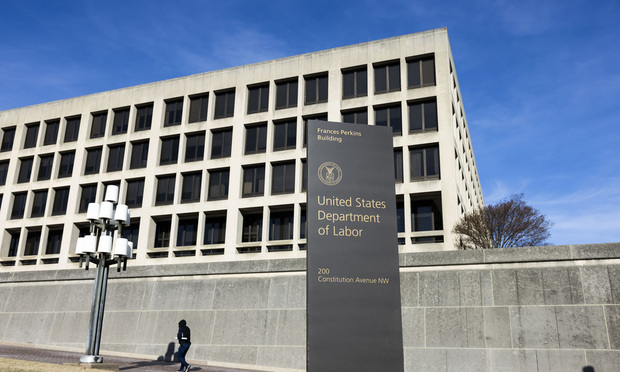 Department of Labor building in Washington, D.C. Photo: Diego M. Radzinschi/ALM
Department of Labor building in Washington, D.C. Photo: Diego M. Radzinschi/ALM
The Labor Department should simplify its proposed rule to encourage participation in automatic portability arrangements in defined contribution plans, the ERISA Industry Committee said on Thursday.
"In implementing this provision, DOL should not impose burdens on plan sponsors or service providers that will unduly discourage participation in automatic portability arrangements," Andrew Banducci, senior vice president for retirement and compensation policy, wrote, in a comment letter on the rule.
Recommended For You
The rule would implement a section of the SECURE 2.0 Act and would allow an automatic portability provider to receive a fee for certain distributions into Safe Harbor IRAs.
Comments on the proposed rule were due Friday. The Labor Department's current regulatory agenda does not indicate when a final rule may be issued.
In his comment letter, Banducci wrote that the DOL has introduced complexity and administrative costs that are not required by the SECURE 2.0 Act. He added that those provisions should be eliminated in any final rule.
He wrote that under the proposed rule, an automatic portability provider would only be provided with transaction relief if the provider can ensure that each plan appoints a plan official who would be responsible for monitoring transfers into the plan and ensuring that any rolled-over funds are properly invested.
"The formal appointment of a plan official in this way is unduly burdensome and will likely discourage sponsors from participating in automatic portability arrangements," Banducci wrote. If the DOL decides to retain this condition in any final rule, the automatic portability provider should be permitted to meet this requirement by confirming that a plan administrator has directed the recordkeeper to invest the rollover this way.
Banducci noted that the law provides for extensive disclosures to retirement savers in a way that the average person can understand it but said that the DOL proposal goes several steps further in imposing burdensome requirements.
For instance, he said, the proposed rule would require auto-portability providers to make non-English language copies of required notices available and to offer non-English language call center support if the provider sends a notice to a terminated participant who resides in a county where 10% or more of the population is literate only in the particular language.
That requirement is not mandated by law and would increase the administrative costs of sponsoring a retirement benefit. That administrative cost ultimately would be borne by plan participants, according to Banducci.
Related: DOL proposes new 401(k) 'auto-portability' regulations for job changers
Banducci said that some plan sponsors already have begun participating in auto-portability programs. Once the DOL rule is finalized, some of those programs will have to be changed to reflect the final rule's provisions. The proposed rule calls for an effective date of 60 days after the final rule is published in the Federal Register. That date should be extended to 180 days, he said. In addition, he said, the DOL should provide transition relief for programs that are operating in good faith with a reasonable interpretation of the SECURE 2.0 Act.
© Touchpoint Markets, All Rights Reserved. Request academic re-use from www.copyright.com. All other uses, submit a request to [email protected]. For more inforrmation visit Asset & Logo Licensing.






